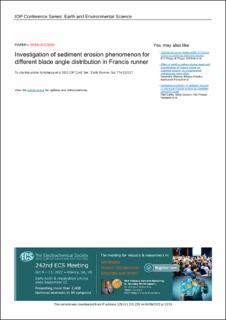| dc.contributor.author | Acharya, Nirmal | |
| dc.contributor.author | Trivedi, Chirag | |
| dc.contributor.author | Gautam, Saroj | |
| dc.contributor.author | Dahlhaug, Ole Gunnar | |
| dc.date.accessioned | 2022-09-06T12:34:57Z | |
| dc.date.available | 2022-09-06T12:34:57Z | |
| dc.date.created | 2021-06-16T11:24:34Z | |
| dc.date.issued | 2021 | |
| dc.identifier.citation | IOP Conference Series: Earth and Environmental Science (EES). 2021, 174 . | en_US |
| dc.identifier.issn | 1755-1307 | |
| dc.identifier.uri | https://hdl.handle.net/11250/3016029 | |
| dc.description.abstract | Wear and tear of hydraulic turbine due to sediment erosion is one of the major problems in hydropower plants located in the Himalayan and Andes regions. High sediment concentration in water of such areas wears down the mechanical components rapidly which causes significant operational challenges. In the present work, a prototype high head Francis runner with speed number 0.32 has been considered as reference case and other designs have been obtained modifying the blade angle distribution with same hydraulic parameters. Full turbine steady state numerical calculations were carried out at the best efficiency point and corresponding performance and erosion pattern are observed. Hydraulic efficiency and sediment erosion rate density are compared for the different cases taken into consideration. Sediment erosion analysis gives an indication of relative erosion intensity and critical zones of erosion damage in runner. Erosion was observed at the inlet near hub and shroud region and was mostly concentrated at the outlet of runner blades for all cases, where relative velocity is higher. Numerical results from CFD are also compared with the actual eroded turbine from the powerplant. | en_US |
| dc.language.iso | eng | en_US |
| dc.publisher | IOP Publishing | en_US |
| dc.rights | Navngivelse 4.0 Internasjonal | * |
| dc.rights.uri | http://creativecommons.org/licenses/by/4.0/deed.no | * |
| dc.title | Investigation of sediment erosion phenomenon for different blade angle distribution in Francis runner | en_US |
| dc.type | Peer reviewed | en_US |
| dc.type | Journal article | en_US |
| dc.description.version | publishedVersion | en_US |
| dc.source.pagenumber | 9 | en_US |
| dc.source.volume | 174 | en_US |
| dc.source.journal | IOP Conference Series: Earth and Environmental Science (EES) | en_US |
| dc.identifier.doi | 10.1088/1755-1315/774/1/012017 | |
| dc.identifier.cristin | 1916091 | |
| dc.relation.project | Norges forskningsråd: 1916091 | en_US |
| dc.relation.project | Norges forskningsråd: 257588 | en_US |
| cristin.ispublished | true | |
| cristin.fulltext | original | |
| cristin.qualitycode | 1 | |

